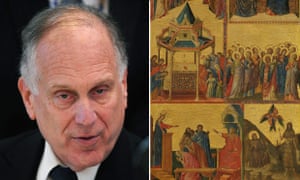The annual press conference presenting the National Gallery's upcoming year in exhibitions took place this week. It was also a formal introduction to the NG's new Director, Gabriele Finaldi and to Hannah Rothschild the new (and first female) Chair of its trustees. They both stressed that in spite of the government's repeated cuts, admission will remain free to all. This is great news not least of all because there has been plenty of gossip about that other museums--all victims of government cuts-- are considering reintroducing admission charges-- in spite of the clear and strong evidence that the numbers visiting soars when people do not have to pay.
Starting in November--may it only be earlier--its galleries will no longer be shut because of strike action. That is when the contract with an external security providing company goes into force. The mismanagement that led to a prolonged strike of the gallery's security employees has been outrageous. Tens of thousands of British and foreign visitors have been unable to see many of the paintings for which the NG is justifiably world famous. Whatever his achievements, Sir Nicholas Penny did not end his stint as Director on a high note.
 Next move: Get the UK government to change the tax laws to encourage philanthropy. Take the lead from the United States where museums and museum goers are enormously enriched because of gifts from private sources. Even the NG is benefiting from that: On view during the the press conference was a beauty of a small painting by Giovanni da Rimini. New York art lover and billionaire Ronald Lauder gave the National Gallery the money to buy the 15th century painting at Sotheby's in London last year. During Mr Lauder's lifetime it will be on public view every three years for three months and otherwise wherever he chooses to display it. Everybody wins.
Next move: Get the UK government to change the tax laws to encourage philanthropy. Take the lead from the United States where museums and museum goers are enormously enriched because of gifts from private sources. Even the NG is benefiting from that: On view during the the press conference was a beauty of a small painting by Giovanni da Rimini. New York art lover and billionaire Ronald Lauder gave the National Gallery the money to buy the 15th century painting at Sotheby's in London last year. During Mr Lauder's lifetime it will be on public view every three years for three months and otherwise wherever he chooses to display it. Everybody wins.




